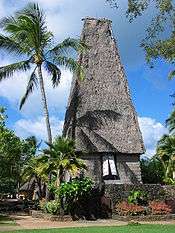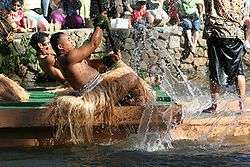Polynesian Cultural Center
The Polynesian Cultural Center (PCC) is a Polynesian-themed theme park and living museum located in Laie, on the northern shore of Oahu, Hawaii.[1] The PCC is owned by The Church of Jesus Christ of Latter-day Saints (LDS Church) and dedicated on October 12, 1963 and occupies 42 acres (17 hectares) of land belonging to nearby Brigham Young University–Hawaii (BYU-Hawaii).[2]
 | |
| Slogan | One Ohana Sharing Aloha |
|---|---|
| Location | 55-370 Kamehameha Highway, Laie, Hawaii, U.S. |
| Coordinates | 21°38′20.63″N 157°55′12.97″W |
| Owner | Corporation of the President of The Church of Jesus Christ of Latter-day Saints |
| Opened | October 12, 1963 |
| Area | 42 acres (17 ha) |
| Website | polynesia |
| Status | Operating |
The PCC encompasses eight simulated tropical villages, in which performers demonstrate various arts and crafts from throughout Polynesia.[3] Visitors may also take a free shuttle tour of the university and see the LDS Church's Laie Hawaii Temple and its associated visitors' center.
Seventy percent of the PCC's approximately 1,300 employees are students at BYU-Hawaii.[4] Since it has opened, the PCC has provided financial assistance to more than 12,000 BYU-Hawaii students.[5] Students may work up to 20 hours per week during school terms and 40 hours during breaks. As a non-profit organization, PCC's revenue are used for daily operations and to support education.
History
In early 1962, then-LDS Church President David O. McKay authorized construction of the nonprofit center as a way to provide employment and scholarships for students at BYU-Hawaii and to preserve the cultures of Polynesia.[6] It has its roots in 1940s and 1950s hukilau and luau beach gatherings to earn money to rebuild a local chapel belonging to the LDS Church, which had been destroyed in a fire. "The Hukilau Song," made famous by Alfred Apaka, was written following the composer and song's original singer, Jack Owens, visit to Lāʻi.e.'s hukilau.[7] In October 1980, Guangdong Party first secretary Xi Zhongxun, father of current Chinese leader Xi Jinping, visited the PCC during a tour of the United States.[8] After the September 11 attacks attendance suffered at the PCC.[9] In 2004, the PCC doubled its advertising budget, "to promote local music, dance and food festivals".[10]

The PCC is one of the most frequently visited tourist destinations in Hawaii, attracting 700,000 visitors annually.[11] The PCC is the venue for the annual World Fire Knife Dance Competition, in which contestants display their skill with blazing swords. Since it opened its doors in 1963, over 32 million people have visited the center. Howard W. Hunter is credited with transforming the newly organized PCC from an unprofitable and unknown entity into one of the most popular tourist attractions in Hawaii.[12]
Activities

Hā–Breath of Life
In addition to the daytime exhibits and demonstrations, PCC features an evening show for an additional charge. As of 2009 the show is a multicultural Polynesian show titled Hā–Breath of Life which The New York Times described as "a vivid, energetic production that highlights song and dance from the indigenous cultures of the South Pacific".[13] The show features songs and dances from throughout Polynesia, including the hula, tamure, otea, titi torea, haka, poi, meke, tauʻolunga, and Taualuga. Past shows include "This is Polynesia", "Mana: The Spirit of Our People.", and Horizons: Where the Sea Meets the Sky. The show reportedly has a cast of 100 performers and they perform six-evenings-a-week.[14]
Huki: A Canoe Celebration
The Lagoon hosts a parade of canoes that showcases the signature dances of each of Polynesian culture. The current show, "Huki: A Canoe Celebration", which premiered in August 2018, was preceded by "Rainbows of Paradise", "This is Polynesia" and "Ancient Legends of Polynesia".
Villages
Each of the major Polynesian cultures has its own section, centered on a traditional village. Hourly performances and cultural learning experiences take place in these villages. Villages include:
|
|
|
|
In addition to the villages, the PCC has a special exhibit dedicated to Rapa Nui (Easter Island or Isla de Pascua) and a tribute to the 1850s LDS mission. Visitors may participate in a luʻau, such as the Aliʻi Luʻau ("Royal Feast"), which offers traditional Polynesian fare, including pork cooked in an imu (an underground oven).[11] They can observe the roasted pig in the imu prior to the meal. The PCC has its own Special effect theater as well as a lagoon where visitors can take canoe rides accompanied by a guide or paddle by themselves.
Special events

PCC hosts many special events, highlighting Hawaiian, Samoan, Tahitian and Māori cultures along with a Christmas festival. The PCC used to host a Haunted Lagoon but discontinued this festival in 2013 due to it not being profitable. Other festivals include Moanikeala Hula festival and World Fireknife Championships and Micronesia Betelnut festival.
References
- Cooper, Jeanne. "Playing tourist at Hawaii’s popular Polynesian Cultural Center", San Francisco Chronicle, 20 December 2012. Retrieved on 11 March 2020.
- Friedman, Fredrica S. "Oahu's Riches: Beaches, Crops And History", The New York Times, 2 July 1978. Retrieved on 11 March 2020.
- Carlton, Michael. "Oahu's North Shore Beach: The Waves Beat On", The Washington Post, 11 January 1981. Retrieved on 10 March 2020.
- "New evening show portrays devotion, loss, and love". Presidents' Report. Brigham Young University-Hawaii and Polynesian Cultural Center: 9. October 2009.
- Myers, Connie. "Polynesian Cultural Center: Cultural Feast, Student Lifeline", BYU Magazine, 2001. Retrieved on 11 March 2020.
- "Polynesian Cultural Center Celebrates 50 Years of Education", Church News, 10 September 2013. Retrieved on 11 March 2020.
- Fidel, Steve. "The Hukilau: A legacy of Laie", Deseret News, 29 October 2009. Retrieved on 11 March 2020.
- Perlez, Jane. "When Xi’s Father Visited, He Met Mickey Mouse and Wore a Leie", The New York Times, 21 September 2015. Retrieved on 11 March 2020.
- Lee, Gary. "Lei of the Land", The Washington Post, 17 March 2002. Retrieved on 10 March 2020.
- "Learning to Relax", Newsweek, 118 February 2004. Retrieved on 11 March 2020.
- Levine, Arthur. "Polynesian Cultural Center: Explore the history of Hawaii and five more islands", USA Today, 12 April 2018. Retrieved on 14 March 2020.
- "President Howard W. Hunter: The Lord's "Good and Faithful Servant"". Retrieved 22 April 2016.
- Tsui, Bonnie. "36 Hours on Oahu", The New York Times, 19 May 2016. Retrieved on 11 March 2020.
- "Behind the Scenes at Polynesian Cultural Center", Hawaii Business, 10 March 2012. Retrieved on 11 March 2020.
External links

- The Official Polynesian Cultural Center Website
- PCC 50 Year Anniversary website (official)